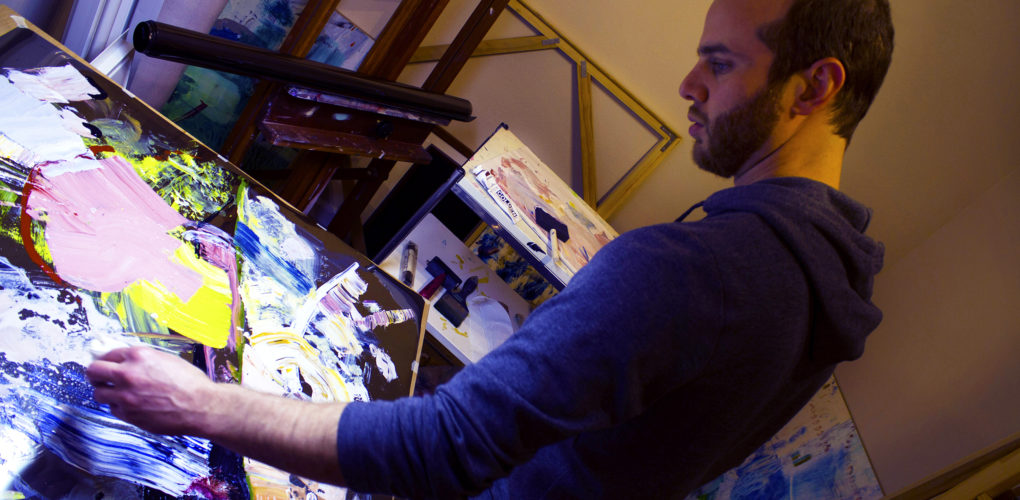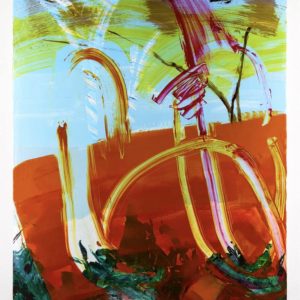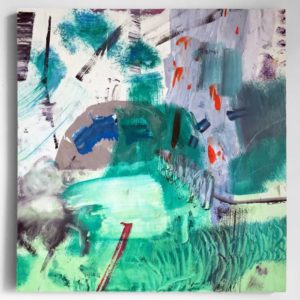One to Watch
 Benjamin Adelmann’s Artworks Are Rooted in Inquiry
Benjamin Adelmann’s Artworks Are Rooted in Inquiry
Benjamin Adelmann sees his practice as an exploration of inquiry. With a background in both the arts and philosophy, he experiments with mediums and develops new processes and techniques to explore epistemological themes. His Inside-Out series, for example, came about while trying to figure out how to step into a new realm, both conceptually and visually. He paints directly onto a film, which he then flips over and presses onto a canvas, allowing him to show the underside of the paint layers on the work’s surface. The result is a new perspective on traditional two-dimensional oil painting.
Benjamin studied Painting at the Tyler School of Art in Philadelphia and has a BA in Philosophy from the California State University Northridge. He was named a winner in ArtSlant’s 2014 Showcase Competition and received a nomination for Masur Museum of Art’s 51st Annual Juried Competition in Monroe, Louisiana. Benjamin has exhibited his works in galleries and art fairs in the US and Japan, including the Geisai #20 Art Fair in Tokyo.
What are the major themes you pursue in your work?
I’m interested in epistemology and metaphysics, but to get to that I need to tangibly produce art that is symbolic and self-inquiring. I love the idea of art being so extrasensory, conditionally connected to the deepest part of humanity, and yet so plain and fixed in the physical. It raises the physical up, makes us look around at the real world in an elevated way. My work structures epistemic symbols (things that question what we know, how we can know, and proposes a new perspective) through the mechanics of its own unique production- and then communicates through that structure, in the painting’s composition.
How did you first get interested in your medium, and what draws you to it specifically?
I paint in anything that serves the project. I started in oils, but I’ve worked in acrylic, watercolor, graphite, colored pencil, etc. I recently renewed my interest in watercolor because it’s so robust and forgiving. My inside-out series is painted in both oil as well as acrylic. The main part of my practice is figuring out how I manipulate the medium through a means that can chip away at the conceptual underpinnings.
How has your style and practice changed over the years?
The Inside-Out series was realized while I lived in Kanagawa, on the outskirts of Tokyo Japan. I was trying to figure out how to step into a new realm both conceptually and visually, and I had bought these weird kinds of plastic films from a huge craft store. I was experimenting with them when I came upon this transfer process. I was so excited that it worked, I made a larger painting and tried to accelerate the drying time (technically “cure”) by leaving the canvas in the sun… well, it dried faster, but the heat shrink-wrapped the film and left a wrinkled texture across the surface like a giant raisin. Never rush art!
Generally though, I think the work has become more about long term ideas that slowly evolve, as well as (and this is kind of contradictory) starting up totally different projects more quickly. I think it’s important to jump into ideas on a whim without becoming too deterministic and “serious” about what direction it might take. Over time, it will prove or disprove itself, but I learn from it and can take that into my more long-term projects.
Can you walk us through your process? Do you begin with a sketch, or do you just jump in? How long do you spend on one work? How do you know when it is finished?
I constantly think about the concept, the execution, and the compositional possibilities. When it comes time to paint, I feel mentally prepared and can relax my thoughts and go at it. Each series has its own complexities to the physical process, which mold the outcome drastically. I think the “making” part of art is integral- I begin by making the wood stretcher bars, stretching the canvas, introducing mediums and pigment onto surfaces, and eventually finishing with a one of a kind art object. What starts out as a set of simple materials comes together to form something more than its parts.
If you couldn’t be an artist, what would you do?
If I couldn’t be an artist, but could be anything else, I’d be an astronaut on the first manned SpaceX rocket- a great way to force fate into a decision between oblivion and glory.
Who are some of your favorite artists, and why?
My work leans towards the serious side, but artists that I enjoy tend to have some humor or purposefully diminutive aspect to them, also some process artists. Some favorites- Yang-Tsung Fan, Alexander Tovborg, Wade Guyton, Ellen Phelan, Wendy White, Chiyu Uemae, Trudy Benson. Greats- Hans Hofmann, Robert Rauschenberg.

















